Type a search term to find related articles by LIMS subject matter experts gathered from the most trusted and dynamic collaboration tools in the laboratory informatics industry.
| Syringe | |
|---|---|
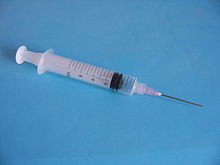 A typical plastic medical syringe fitted with a detachable stainless steel needle; the syringe is fitted with a male Luer lock fitting which the needle, which is equipped with a female Luer-Lock fitting (purple), screws into | |
| Classification | Medical device |
| Industry | Healthcare |
| Application | Injection |
| Inventor | Charles Pravaz (screw) Alexander Wood (plunger) |
| Invented | 1853 |

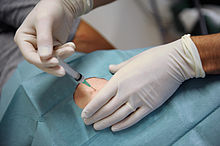
A syringe is a simple reciprocating pump consisting of a plunger (though in modern syringes, it is actually a piston) that fits tightly within a cylindrical tube called a barrel. The plunger can be linearly pulled and pushed along the inside of the tube, allowing the syringe to take in and expel liquid or gas through a discharge orifice at the front (open) end of the tube. The open end of the syringe may be fitted with a hypodermic needle, a nozzle or tubing to direct the flow into and out of the barrel. Syringes are frequently used in clinical medicine to administer injections, infuse intravenous therapy into the bloodstream, apply compounds such as glue or lubricant, and draw/measure liquids. There are also prefilled syringes (disposable syringes marketed with liquid inside).
The word "syringe" is derived from the Greek σῦριγξ (syrinx, meaning "Pan flute", "tube").



Sectors in the syringe and needle market include disposable and safety syringes, injection pens, needleless injectors, insulin pumps, and specialty needles.[2] Hypodermic syringes are used with hypodermic needles to inject liquid or gases into body tissues, or to remove from the body. Injecting of air into a blood vessel is hazardous, as it may cause an air embolism; preventing embolisms by removing air from the syringe is one of the reasons for the familiar image of holding a hypodermic syringe pointing upward, tapping it, and expelling a small amount of liquid before an injection into the bloodstream.
The barrel of a syringe is made of plastic or glass, usually has graduated marks indicating the volume of fluid in the syringe, and is nearly always transparent. Glass syringes may be sterilized in an autoclave. Plastic syringes can be constructed as either two-part or three-part designs. A three-part syringe contains a plastic plunger/piston with a rubber tip to create a seal between the piston and the barrel, where a two-part syringe is manufactured to create a perfect fit between the plastic plunger and the barrel to create the seal without the need for a separate synthetic rubber piston. Two-part syringes have been traditionally used in European countries to prevent introduction of additional materials such as silicone oil needed for lubricating three-part plungers.[3] Most modern medical syringes are plastic because they are cheap enough to dispose of after being used only once, reducing the risk of spreading blood-borne diseases. Reuse of needles and syringes has caused spread of diseases, especially HIV and hepatitis, among intravenous drug users. Syringes are also commonly reused by diabetics, as they can go through several in a day with multiple daily insulin injections, which becomes an affordability issue for many. Even though the syringe and needle are only used by a single person, this practice is still unsafe as it can introduce bacteria from the skin into the bloodstream and cause serious and sometimes lethal infections.[4] In medical settings, single-use needles and syringes effectively reduce the risk of cross-contamination.[5]
Medical syringes are sometimes used without a needle for orally administering liquid medicines to young children or animals, or milk to small young animals, because the dose can be measured accurately and it is easier to squirt the medicine into the subject's mouth instead of coaxing the subject to drink out of a measuring spoon.
Syringes come with a number of designs for the area in which the blade locks to the syringe body. Perhaps the most well known of these is the Luer lock, which simply twists the two together.
Bodies featuring a small, plain connection are known as slip tips and are useful for when the syringe is being connected to something not featuring a screw lock mechanism.
Similar to this is the catheter tip, which is essentially a slip tip but longer and tapered, making it good for pushing into things where there the plastic taper can form a tight seal. These can also be used for rinsing out wounds or large abscesses in veterinary use.
There is also an eccentric tip, where the nozzle at the end of the syringe is not in the centre of the syringe but at the side. This causes the blade attached to the syringe to lie almost in line with the walls of the syringe itself and they are used when the blade needs to get very close to parallel with the skin (when injecting into a surface vein or artery for example).
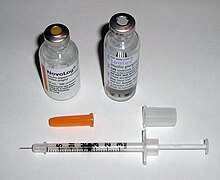
Syringes for insulin users are designed for standard U-100 insulin. The dilution of insulin is such that 1 mL of insulin fluid has 100 standard "units" of insulin.[6] Since insulin vials are typically 10 mL, each vial has 1000 units.
Insulin syringes are made specifically for self injections and have friendly features:
|
U-100 syringe sizes and markings | |
|---|---|
| 1cc (1 mL) Syringe | |
| Holds maximum: | 100 units[10] |
| Numbered in: | 10 unit increments[10] |
| Smallest line measures 2 units:[11] | BD[10] ReliOn[12] Monoject[13] (all but 31 gauge needle) |
| Smallest line measures 1 unit: | Easy Touch[14] Precision Sure Dose[13] |
| 1/2cc (0.5 mL) Syringe | |
| Holds maximum: | 50 units[15] |
| Numbered in: | 10 unit increments[15] |
| Smallest line measures 1 unit:[11] | BD[15] Precision Sure Dose[13] Ulti-Care[13][16] Easy Touch[17] ReliOn[12] Monoject[13] |
| 3/10cc (0.3 mL) Syringe | |
| Holds maximum: | 30 units[18] |
| Numbered in: | 5 unit increments[18] |
| Smallest line measures 1 unit:[11] | BD Micro Fine[13] BD Ultra Fine[13][18] (standard length only) Monoject[13] Easy Touch[19] UltiCare[13] |
| Half-unit scale 3/10cc (0.3 mL) Syringe[20] | |
| Holds maximum: | 30 units[18] |
| Numbered in: | 5 unit increments[18] |
| Smallest line measures 1/2 unit: | BD Ultra Fine II (short)[13][18] ReliOn[12][13] |
There are needle syringes designed to reload from a built-in tank (container) after each injection, so they can make several or many injections on a filling. These are not used much in human medicine because of the risk of cross-infection via the needle. An exception is the personal insulin autoinjector used by diabetic patients and in dual-chambered syringe designs intended to deliver a prefilled saline flush solution after the medication.[21]
Venom extraction syringes are different from standard syringes, because they usually do not puncture the wound. The most common types have a plastic nozzle which is placed over the affected area, and then the syringe piston is pulled back, creating a vacuum that allegedly sucks out the venom. Attempts to treat snakebites in this way are specifically advised against, as they are ineffective and can cause additional injury.[22]
Syringes of this type are sometimes used for extracting human botfly larvae from the skin.[23]
An oral syringe is a measuring instrument used to accurately measure doses of liquid medication, expressed in millilitres (mL). They do not have threaded tips, because no needle or other device needs to be screwed onto them. The contents are simply squirted or sucked from the syringe directly into the mouth of the person or animal.
Oral syringes are available in various sizes, from 1–10 mL and larger. An oral syringe is typically purple in colour to distinguish it from a standard injection syringe with a luer tip.[24] The sizes most commonly used are 1 mL, 2.5 mL, 3 mL, 5 mL and 10 mL.[25]
A dental syringe is used by dentists for the injection of an anesthetic.[26] It consists of a breech-loading syringe fitted with a sealed cartridge containing an anesthetic solution.
In 1928, Bayer Dental developed, coined and produced a sealed cartridge system under the registered trademark Carpule®. The current trademark owner is Kulzer Dental GmbH.
The carpules have long been reserved for anesthetic products for dental use. It is practically a bottomless flask. The latter is replaced by an elastomer plug that can slide in the body of the cartridge. This plug will be pushed by the plunger of the syringe. The neck is closed with a rubber cap. The dentist places the cartridge directly into a stainless steel syringe, with a double-pointed (single-use) needle. The tip placed on the cartridge side punctures the capsule and the piston will push the product. There is therefore no contact between the product and the ambient air during use.
The ancillary tool (generally part of a dental engine) used to supply water, compressed air or mist (formed by combination of water and compressed air) to the oral cavity for the purpose of irrigation (cleaning debris away from the area the dentist is working on), is also referred to as a dental syringe or a dental irrigation nozzle.
A 3-way syringe/nozzle has separate internal channels supplying air, water or a mist created by combining the pressurized air with the waterflow. The syringe tip can be separated from the main body and replaced when necessary.
In the UK and Ireland, manually operated hand syringes are used to inject lidocaine into patients' gums.[27][28][26]

A dose-sparing syringe is one which minimises the amount of liquid remaining in the barrel after the plunger has been depressed. These syringes feature a combined needle and syringe, and a protrusion on the face of the plunger to expel liquid from the needle hub. Such syringes were particularly popular during the COVID-19 pandemic as vaccines were in short supply.[29]
In some jurisdictions, the sale or possession of hypodermic syringes may be controlled or prohibited without a prescription,[30] due to its potential use with illegal intravenous drugs.[31]
The syringe has many non-medical applications.
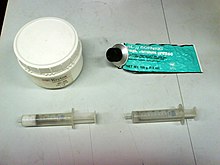
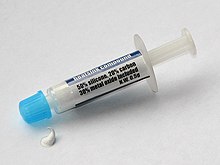
Medical-grade disposable hypodermic syringes are often used in research laboratories for convenience and low cost. Another application is to use the needle tip to add liquids to very confined spaces, such as washing out some scientific apparatus. They are often used for measuring and transferring solvents and reagents where a high precision is not required. Alternatively, microliter syringes can be used to measure and dose chemicals very precisely by using a small diameter capillary as the syringe barrel.
The polyethylene construction of these disposable syringes usually makes them rather chemically resistant. There is, however, a risk of the contents of the syringes leaching plasticizers from the syringe material. Non-disposable glass syringes may be preferred where this is a problem. Glass syringes may also be preferred where a very high degree of precision is important (i.e. quantitative chemical analysis), because their engineering tolerances are lower and the plungers move more smoothly. In these applications, the transfer of pathogens is usually not an issue.
Used with a long needle or cannula, syringes are also useful for transferring fluids through rubber septa when atmospheric oxygen or moisture are being excluded. Examples include the transfer of air-sensitive or pyrophoric reagents such as phenylmagnesium bromide and n-butyllithium respectively. Glass syringes are also used to inject small samples for gas chromatography (1 μl) and mass spectrometry (10 μl). Syringe drivers may be used with the syringe as well.
Some culinary uses of syringes are injecting liquids (such as gravy) into other foods, or for the manufacture of some candies.
Syringes may also be used when cooking meat to enhance flavor and texture by injecting juices inside the meat, and in baking to inject filling inside a pastry. It is common for these syringes to be made of stainless steel components, including the barrel. Such facilitates easy disassembly and cleaning.
Syringes are used to refill ink cartridges with ink in fountain pens.
Common workshop applications include injecting glue into tight spots to repair joints where disassembly is impractical or impossible; and injecting lubricants onto working surfaces without spilling.
Sometimes a large hypodermic syringe is used without a needle for very small baby mammals to suckle from in artificial rearing.
Historically, large pumps that use reciprocating motion to pump water were referred to as syringes. Pumps of this type were used as early firefighting equipment.
There are fountain syringes where the liquid is in a bag or can and goes to the nozzle via a pipe. In earlier times, clyster syringes were used for that purpose.
Loose snus is often applied using modified syringes. The nozzle is removed so the opening is the width of the chamber. The snus can be packed tightly into the chamber and plunged into the upper lip. Syringes, called portioners, are also manufactured for this particular purpose.
